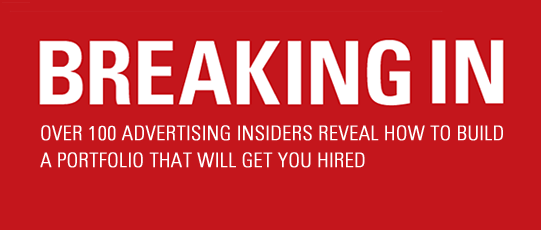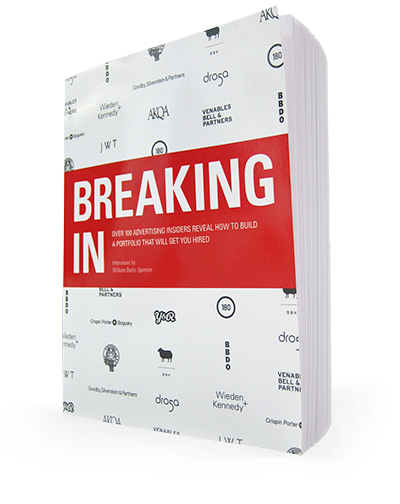David Carter is Senior Creative Director at BBDO New York.
Starbucks Love Project
HBO Voyeur

 Follow on Twitter
Follow on Twitter
David Carter is Senior Creative Director at BBDO New York.
Starbucks Love Project
HBO Voyeur
Read the full interview in BREAKING IN: Learn more about the book or Buy it on Amazon
If you missed it, check out some great work from Matt Orser.
WS: What do you look for in a student book? And what impresses you?
MO: I want to be jealous. If I see something that makes me think, “Wow, I wish I did that.” That’s it. That’s all I look for. Because if I was inspired enough by one thing that I saw, that would make it memorable and make it good. It seems like it’s easy but it’s not. It’s really hard to do.
WS: Do you think a student book needs to be finished, or could it just be sketches?
MO: I think student books definitely should be as finished as possible. And I think that everything in the book should be very easy to understand. I feel like I see a lot of stuff nowadays where we’re doing a lot more integrated types of campaigns, especially within our books. And it is a trick sometimes to show it in the proper way, and if it is at all confusing, it just loses all of its importance. And that’s why it always has to be really finished, and tight, and solid because I need to be able to just flip through it. No one’s going to spend that much time. I think a book needs to be polished because then you just understand it quicker. That’s it.
Read the full interview in BREAKING IN: Learn more about the book or Buy it on Amazon
Read the full interview in BREAKING IN: Learn more about the book or Buy it on Amazon
In case you missed it, check out an open letter from Rick Boyko to the next director of the VCU Brandcenter.
WS: What do you look for in a student book? And what impresses you?
RB: What I have always looked for in any book are consistent conceptual and strategic solutions to legitimate business problems. No longer can books be filled with fun, little, easy-to-do, local-business print executions. We challenge Brandcenter students to take on real brands with difficult problems as assignments. Then they have to build out communications across whatever mediums best come in contact with the target, which in almost all cases include or begin with a digital, social component. Any book that does not demonstrate the ability to think about real brands strategically across multiple mediums will most likely not even get a viewing by most agencies today.
WS: How important is finish? If ideas are the most important thing, can sketches be enough? Do you look at actual books anymore, or is it all websites?
RB: Execution is still very important because craft still matters. You have to be able to demonstrate that you are not just someone who can think strategically and conceptually but you can also execute. So, while ideas are king, being able to bring them to life is just as important. While most books today are first viewed on a website, I still believe having a tangible one is valuable to bring the thinking to life and helpful in judging craft.
[ … ]
Read the full interview in BREAKING IN: Learn more about the book or Buy it on Amazon
Rick Boyko is the outgoing Director of the VCU Brandcenter and former Co-President & Chief Creative Officer of Ogilvy North America. Here is an open-letter he wrote to the next director of the school, for whom an active search is underway.
Over the past eight years it is has been my privilege and pleasure to have taught and learned from the over 700 VCU Brandcenter students who have graduated and gone on to work at just about every agency in the world including Wieden+Kennedy, TBWA/Chiat/Day, Goodby Silverstein & Partners, CP+B, Martin Agency and Droga 5, as well as with marketers like Target, Audi, Nike, Anthropologie, Lego, Google and Microsoft.
During my tenure, each class of students has demonstrated they expect and want to be challenged by someone who will instill in them a passion and caring for our craft. I’ve also witnessed a movement by them as they have transitioned from doing ads to having a distinct interest in solving marketing problems by bringing a brand story to life in new ways, which adds meaning and value to a greater good. One good example of this is our recent Still4Japan web, PR and social-media campaign, which will urge people to remember the tsunami victims.
Read the full interview in BREAKING IN: Learn more about the book or Buy it on Amazon
In case you missed it, check out some great work from Fredrik Carlström.
[ … ]
FC: …I think it all comes down to how you thought about it. And how you solved the problem. At the end of the day, you have to walk in with your ideas and think that they are good, and if you don’t get hired it’s because the person who met with you didn’t. So what? You will find someone who does like your ideas and that’s where you want to work.
WS: What do you think about seeing books with things that aren’t ads in them? Other writing, or journal entries, or photography, or art projects?
FC: Good and bad. If you are looking for work in advertising, show that you know how to do advertising. If you can explain why your diary or poetry is relevant to me and why I should hire you based off them, kudos to you. But sometimes you see a book with lousy work, but great photography, or great something else, and you can’t help but think, “Maybe you should do this instead because you’re obviously better at it and you like it more.” Again, show anything that shows that—and how—you’re thinking and that you can speak about intelligently.
Read the full interview in BREAKING IN: Learn more about the book or Buy it on Amazon
Fredrik Carlström is CEO & Chief Creative Officer of Great Works America, New York.
Absolut Vodka
FC: The visionaries program was an entertainment platform created for ABSOLUT Vodka where creative influencers were asked to create a unique piece of content under the banner “In An Absolut World”.
“In An Absolut World, Friends Would Get Together More Often” by Zach Galifianakis, Tim Heidecker and Eric Wareheim”
Part 2
“In An Absolut World, Would Machines Be Creative?” by Dan Paluska & Jeff Lieberman and Teenage Engineering
Read the full interview in BREAKING IN: Learn more about the book or Buy it on Amazon
In case you missed it, check out some great work from Brian Fraser.
WS: What do you look for in a student book? And what impresses you?
BF: Freshness. But that’s a bit broad, isn’t it? I think the most difficult thing about putting a book together is to put a book together that looks and feels and sounds different from other books. And that in itself is really hard. Because I think part of the problem is you’ve got—as it is now—you’ve got an advertising course. What tends to happen, particularly in this country, whether it be Watford or Hounslow or whatever, a lot of the students come out looking and feeling the same. So that’s kind of a downside to that course, I guess.
But it’s a point of view of freshness—a way of thinking about solving a problem in a lateral way, really, because that’s what we do. I mean, we get paid for solving problems as creatively as we possibly can. Ability to think across media platforms is a given, I guess, and it’s obvious. Even though, surprisingly, you still don’t see a huge amount of that in student books.
For me, I have a bugbear about a lot of student books. I just did a D&AD [Design & Art Direction, a British educational organization] workshop, which I haven’t done for about 10 years, but I thought it’d be interesting to see. Simon and I did one and about 26, 30 of them turned up—a great bunch of kids, very bright. Fantastic ideas. But I said, “Who’s the art director? Who’s a copywriter?” No one put their hands up. They did both roles. So I think if you want to make a difference putting a book together, to have some sort of cross skills is a huge advantage. Particularly some sort of art direction skills because what I see a lot of is the inability to be able to put things together. Having great ideas isn’t enough. If you can’t convert them, then they’re not great ideas, they’re bad ideas. So that’s worth thinking about when you put a book together.
Read the full interview in BREAKING IN: Learn more about the book or Buy it on Amazon
Read the full interview in BREAKING IN: Learn more about the book or Buy it on Amazon
Interviewed at 180, Amsterdam
WS: What do you look for in a student book? And what impresses you?
AB: What I look for is originality of ideas—big ideas. And then what impresses me is the personal piece. That’s a big thing we look for. Not just making spec work and what the young creatives think the recruiter or the agency wants to see, but showing a piece of themselves. So whether it’s photography, or personal projects, or things like that. That’s big for us [at 180].
WS: Are sketches enough, or do you want to see finished work?
AB: Nowadays, more finished work. Sketches are now almost old school for us. And we really look for craft as well. So, in terms of art direction, there needs to be some design influence and hands-on capability and for copywriters as well, no longer just little script ideas, they’ve got to be able to put the whole thing together.
Read the full interview in BREAKING IN: Learn more about the book or Buy it on Amazon